This post contains affiliate links.
This article identifies all hummingbirds documented as seen in Connecticut and where they are seen in the state. It further identifies if that specific hummingbird species is a year-round resident, a seasonal visitor, or a rare vagrant hummingbird seen in Connecticut.
Which Species Of Connecticut Hummingbirds Are Found In The State?
There are six species of hummingbirds documented as seen in Connecticut.
Documented Connecticut hummingbirds, listed in order of frequency seen are Ruby-throated, Rufous, Calliope, Black-chinned, Broad-billed, and Mexican violetear hummingbirds.
Top Google-ranked websites recognize one additional hummingbird, Anna’s, as a Connecticut hummingbird, despite the fact there are just six species recorded as being seen in Connecticut on a national hummingbird sighting map.
Listed In The Order Of Frequency Seen:
These are the Connecticut statistics at the end of 2023, as reported by eBird.org.
Click the “Documented” link below for the current Connecticut stats.
| Hummingbirds: | Number Seen: | Documented |
| Ruby-throated | 47,918 | Documented |
| Rufous | 345 | Documented |
| Calliope | 45 | Documented |
| Black-chinned | 26 | Documented |
| Broad-billed | 1 | Documented |
| Mexican violetear | 1 | Documented |
| White-eared | 0 | Documented |
| Total Seen: | 48,336 |
These 7 hummingbird species found in Connecticut and are further classified into three groups:
Year-round residents, Seasonal visitors, and Rare/Vagrant visitors.
| Hummingbird: | Year-Round, Seasonal, Rare/Vagrant |
| Ruby-throated | Seasonal |
| Rufous | Rare/Vagrant |
| Calliope | Rare/Vagrant |
| Black-chinned | Rare/Vagrant |
| Broad-billed | Rare/Vagrant |
| Mexican violetear | Rare/Vagrant |
| White-eared | Rare/Vagrant |
For more information on Connecticut hummingbirds: Read my article: Connecticut Hummingbird Migration
Connecticut Hummingbirds That Are Year-Round Residents
There are no hummingbirds classified as year-round residents in Connecticut.
This hummingbird classification is defined as year-round residents residing in Connecticut 365 days a year.
Contrary to popular belief, hummingbirds can withstand far lower temperatures than most people would expect.
Some banded hummingbirds have been observed at temperatures as low as -9 degrees Fahrenheit with a wind chill of -36 degrees Fahrenheit, according to eBird.
See my article: 3 Reasons Why Hummingbirds Are Banded
Connecticut Hummingbirds That Are Seasonal
There is 1 Connecticut hummingbird classified as a seasonal hummingbird which is the Ruby-throated hummingbird.
Hummingbirds that fit within this category are those that migrate through Connecticut on a spring or fall emigration basis.
Hummingbirds move south to spend the winter in Mexico and Central America in the fall, after migrating north in the spring to reproduce.
Due to their preference, an ailment, or advanced age, certain seasonal hummingbirds may spend the whole winter in the state.
To see a current sighting map of Connecticut’s seasonal hummingbirds, click the links below:
RUBY-THROATED HUMMINGBIRD – (Archilochus colubris)
Conservation Status: Least concerned
Kingdom: Animalia
Phylum: Chordata
Class: Aves
Order: Apodiformes
Family: Trochilidae
Genus: Archilochus
Species: A. colubris
Scientist Carl Linnaeus of Sweden is credited with giving the Ruby-throated hummingbird its scientific name. He initially classified the species as “Trochilus colubris.” Its name was revised more than a century later when German botanist Ludwig Reichenbach classed it as “Archilochus colubris,” which is now its scientific name and means “sky spirit/sun-god bird” or “top thief.”
Male Ruby-throated hummingbirds:
The beautiful iridescent blood-red gorget of male ruby-throated hummingbirds ends at the neck.
His distinctive features are black wings, a light gray underbelly, and a dull metallic green topside.
The Ruby-throated hummingbird is a tiny species of hummingbird, measuring 2.8 to 3.3 inches in length and weighing less than 4.5 grams, or two U.S. dimes.
They live for three to five years on average.
The metal plate that shields the wearer’s throat during combat to prevent injuries is the inspiration behind the name of the gorget on a male hummingbird. This name is acceptable and fitting to characterize the physical characteristics of male hummingbirds, since they fight fiercely for their own territory.
Read my article: Hummingbird Gorgets Explained
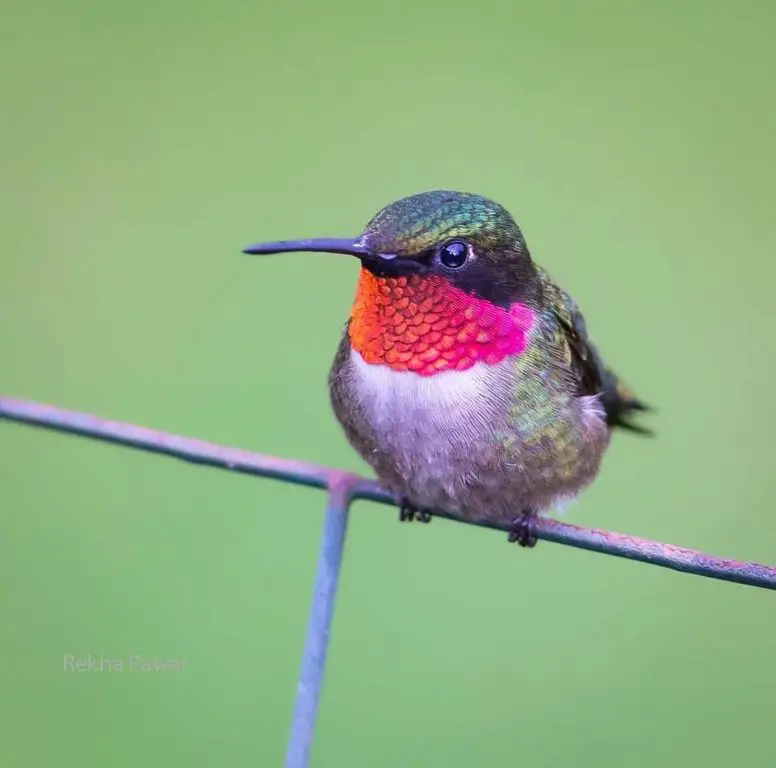
Photo by: Rekha Pawar

Photo by: mz13hummingbirds
Female Ruby-throated hummingbirds:
Ruby-throated hummingbird females are usually larger than males, with a white throat stippled with light spots.
Ruby-throated hummingbird’s life expectancy is roughly three to five years.
The oldest female Ruby-throated hummingbird on record, at nine years old, is nearly twice as old as the male life expectancy.
See my article: Hummingbird Parents: (Mating to Nesting)

Photo by: Dgen.photos
Note: The pollen on her head and beak. This female Ruby-throated hummingbird has been busy pollinating and drinking nectar from flowers to sustain her high metabolism.
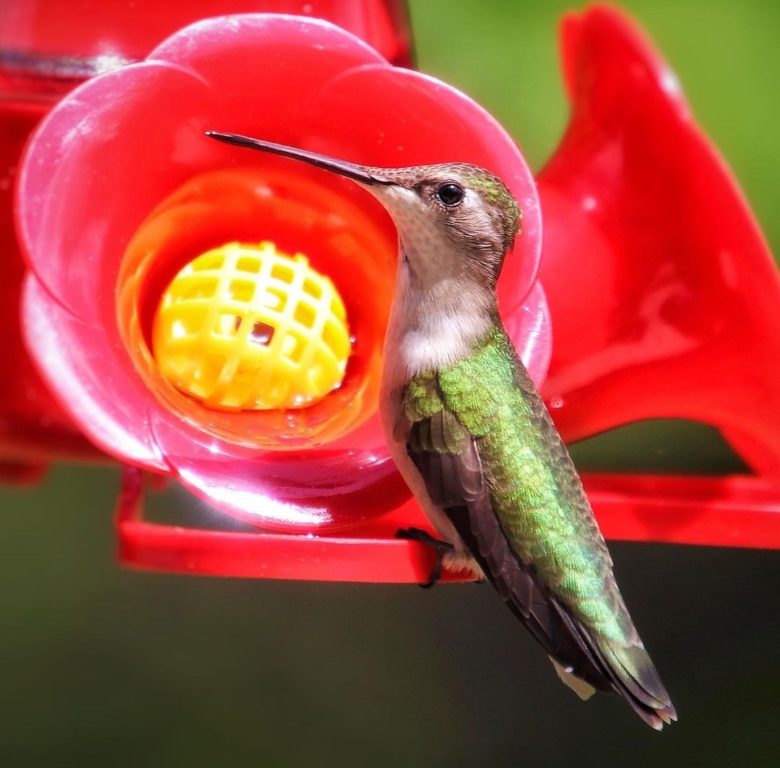
Photo by: Paula Leftwich
Juvenile Ruby-throated hummingbirds:
Ruby-throated hummingbird juveniles, both male and female, have a white throat with faint stippling, just like their mother.
As the males become older, they start to show some color around their necks, and finally their stronger red throat feathers take center stage and proudly show off a vibrant gorget.

Photo by: MaryLou Ziebarth
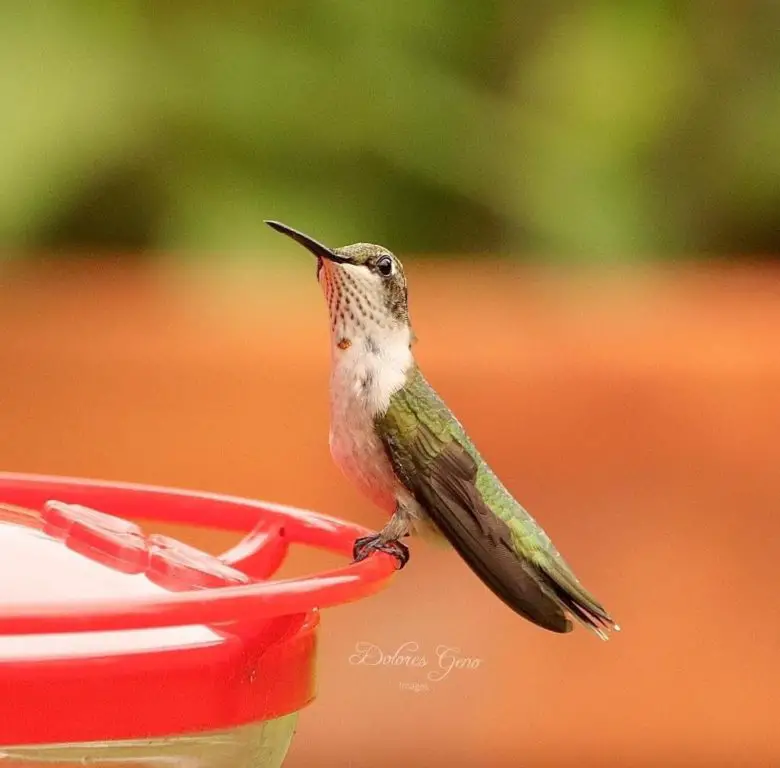
Photo by: Dgen.photos
Note: The throat feathers are slowly coming in, displaying a few dots of color near the neckline and showing the first stages of adolescence.
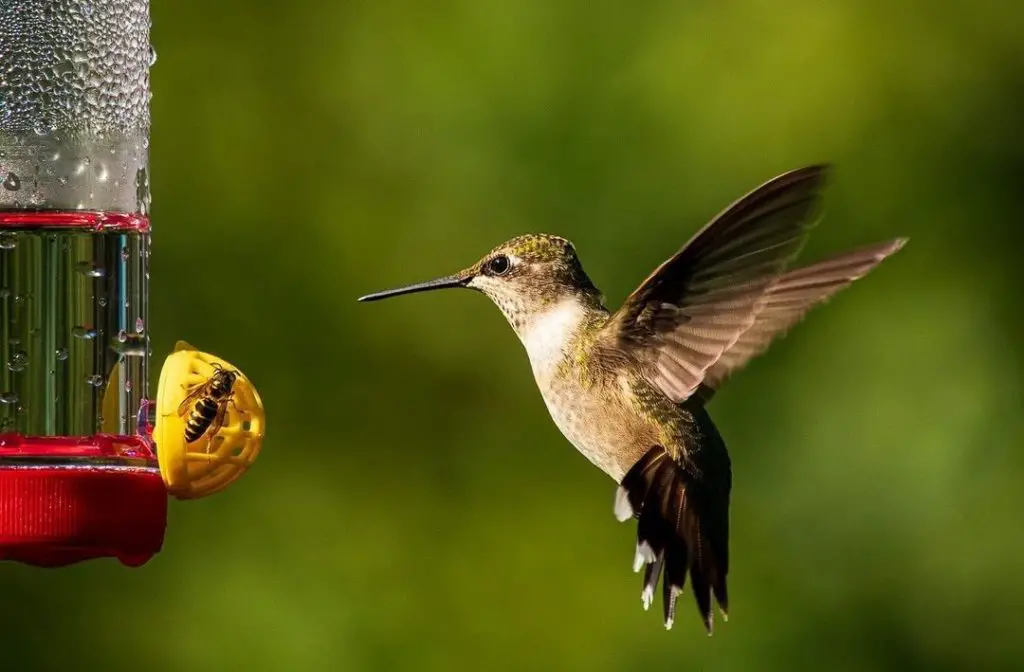
Photo by: MaryLou Ziebarth
Note: This juvenile Ruby-throated hummingbird is struggling with a bee or wasp situation at the feeder.
See my article: Bees On My Hummingbird Feeder: (9 Tips To Get Rid of Them)
Baby Ruby-throated hummingbirds:
Baby Ruby-throated hummingbirds are easily identified by their undertail coverts, which are white fluffy feathers near their bottom that will disappear as they age.
See my article: Baby Hummingbirds: (Egg to Fledgling)
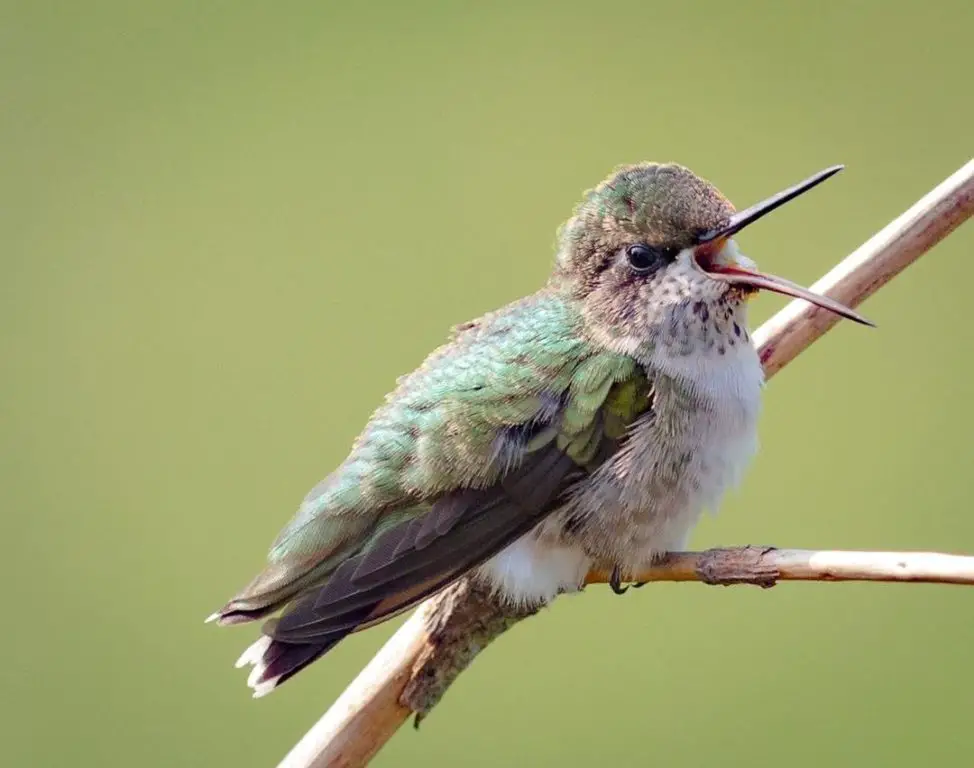
Photo by: Rekha Pawar
Note: The down feathers near the baby’s bottom are newly white and fluffy.
Also, observe the great fat reserves they have amassed from the feedings of their devoted mother’s, which will help them get through puberty.
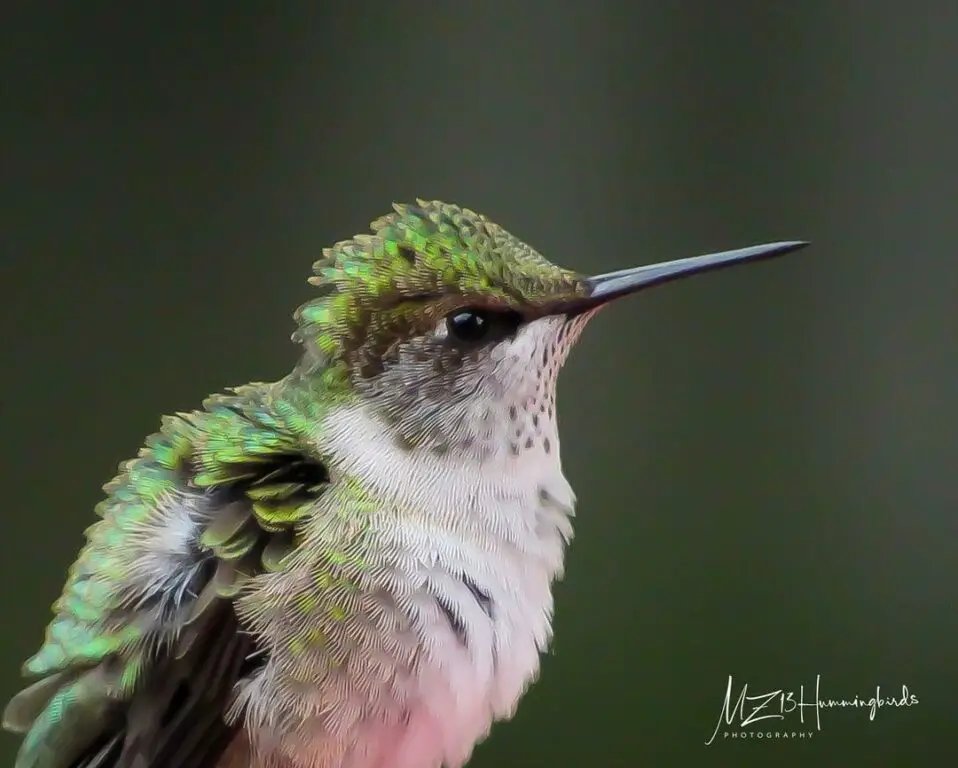
Photo by: Mz13hummingbirds
To see the current sighting map of Connecticut’s Ruby-throated hummingbirds, click the link.
Hear the sounds of the Ruby-throated hummingbird (Cornell Lab of Ornithology link).
99% of all Connecticut hummingbird sightings will be Ruby-throated hummingbirds.
On average, out of 10,000 hummingbird sightings in Connecticut, 9,913 will be of the Ruby-throated hummingbird.
The Ruby-throated Hummingbird migrates via two different routes in the spring and fall.
The first migration route takes them directly, via the Gulf of Mexico, southwest to Mexico, where they travel nonstop and exhaustingly until they reach Central America for the winter. Over 500 miles is the flight distance over the Gulf of Mexico. Despite being the direct “short” route, these birds must overcome many difficulties.
The total direct flight from Hartford, Connecticut to Panama City, Panama is 2,295 miles.
Not being able to rest, not having access to food or fuel, and needing to steer clear of the severe tropical Atlantic hurricanes while traveling to their destination are some of the challenges faced when flying over the Gulf of Mexico. To exacerbate the situation, they migrate during the night or are conducting a “Red-eye flight,” depending on your point of view.
Even though both sexes double their body fat before beginning their arduous transoceanic migratory pattern across the Gulf of Mexico, researchers think that males’ energy consumption is more taxing due to their small stature.
The second land migration path is 4,600 miles long and follows the Gulf of Mexico’s shoreline. Even though there are fewer guarantees of food sources along the way, taking the “long” route gives them the chance to stop and replenish.
Scientists are unclear and continue to investigate why one group of birds would prefer to take one route over the other.
Read my article: Hummingbird Migration in Connecticut
The Ruby-throated hummingbird is a common sight in parks, gardens, and backyards. It prefers open forests. Except for the breeding season, when they become ferociously territorial and hostile against hummingbirds of other species, they are solitary birds.
Despite their aggressive nature, these hummingbirds are eaten by predators like dragonflies, big crustaceans, praying mantises, and orb-weaver spiders.
Read my article: 10 Common Things That Kill Hummingbirds
Nine years and one month was the oldest known living female Ruby-throated hummingbird, found during a capture and release banding operation in West Virginia.
Read my article: 3 Reasons Why Hummingbirds Are Banded
Connecticut Hummingbirds That Are Rare/Vagrant
There are 6 Connecticut hummingbirds classified as rare or vagrant hummingbirds. They are the Rufous, Calliope, Black-chinned, Broad-billed, Mexican violetear, and White-eared hummingbirds.
Hummingbirds that live in a group outside of their typical geographic range are classified as belonging to this category. These hummingbird species not only span a vast range of distinct geographic areas, but they are also known to occasionally interbreed, giving rise to hybrids.
Although they are not in their usual range, reports of seeing these hummingbirds in Connecticut have been made.
To see a current sighting map of Connecticut rare/vagrant hummingbirds, click the links below:
RUFOUS HUMMINGBIRD – (Selasphorus rufus)
Conservation Status: Near threatened
Kingdom: Animalia
Phylum: Chordata
Class: Aves
Order: Apodiformes
Family: Trochilidae
Genus: Selasphorus
Species: S. rufous
The Latin word rubrum, which means “red,” is the source of the Rufous hummingbird’s name due to its reddish-brown color.
Male Rufous hummingbirds:
The orange-red gorget of a male rufous hummingbird is iridescent, and their tail and sides have a rusty hue. Their underside is beige to white, and their bill is black. Along with chocolate brown dorsal feathers, males can also have green plumage with green spots on their rustic-looking backs or on the summit of their heads.
They weigh 3.2 grams and range in length from 2.8 to 3.5 inches.
The metal plate that shields the wearer’s throat during combat to prevent injuries is the inspiration behind the name of the gorget on a male hummingbird. This name is acceptable and fitting to characterize the physical characteristics of male hummingbirds, since they fight fiercely for their own territory.
Read my article: Hummingbird Gorgets Explained
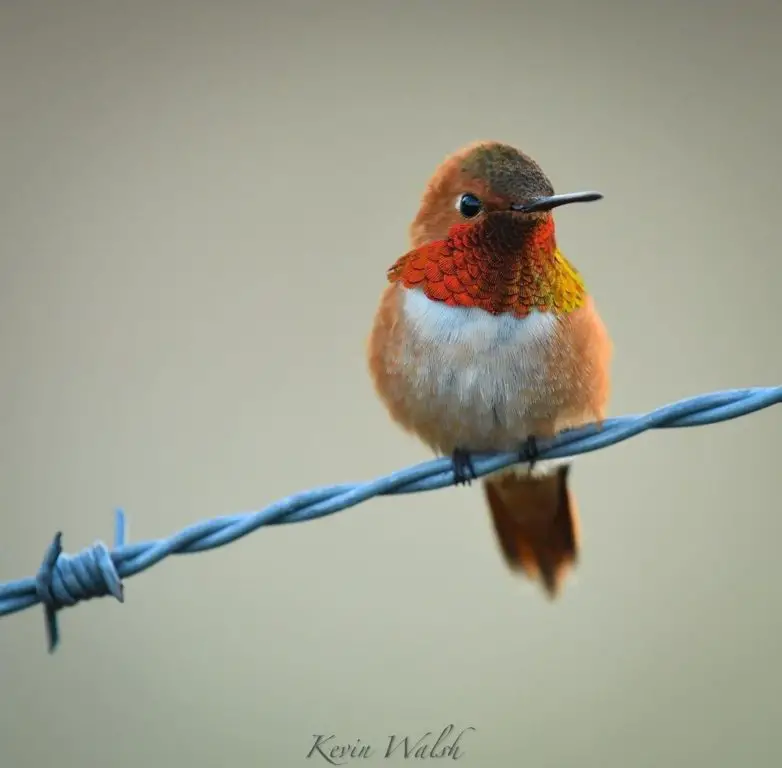
Photo by: Kevin Walsh
Note: The iridescent orange-red gorget.
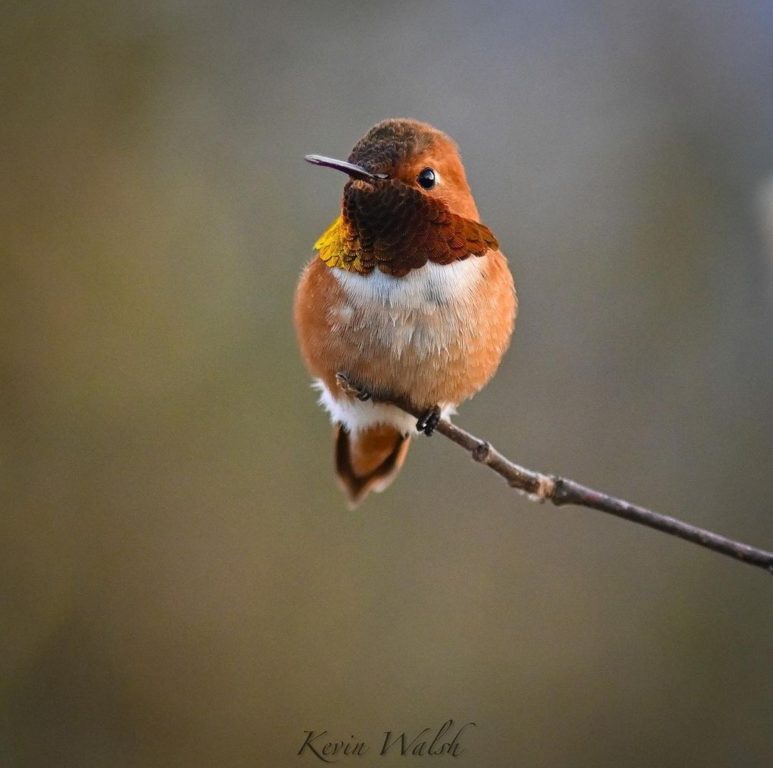
Photo by: Kevin Walsh
Note: The gorget appears chocolate brown in this lighting, however, you can still see a glimmer of his iridescent orange-red gorget with some hints of yellow.
Female Rufous hummingbirds:
The female Rufous hummingbird is less colorful than the male because it lacks a gorget and iridescent feathers. In the wild, confusion may arise, though, because certain females have stippling or color specs along their throat line that resemble juvenile characteristics.
They are slightly larger than the males in anticipation of producing offspring.
See my article: Hummingbird Parents: (Mating to Nesting)
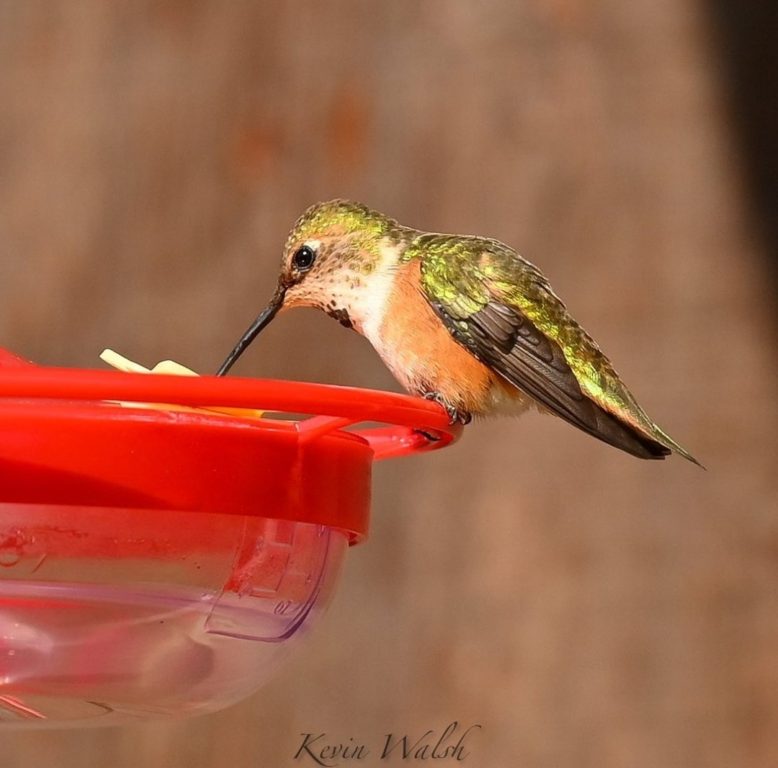
Photo by: Kevin Walsh
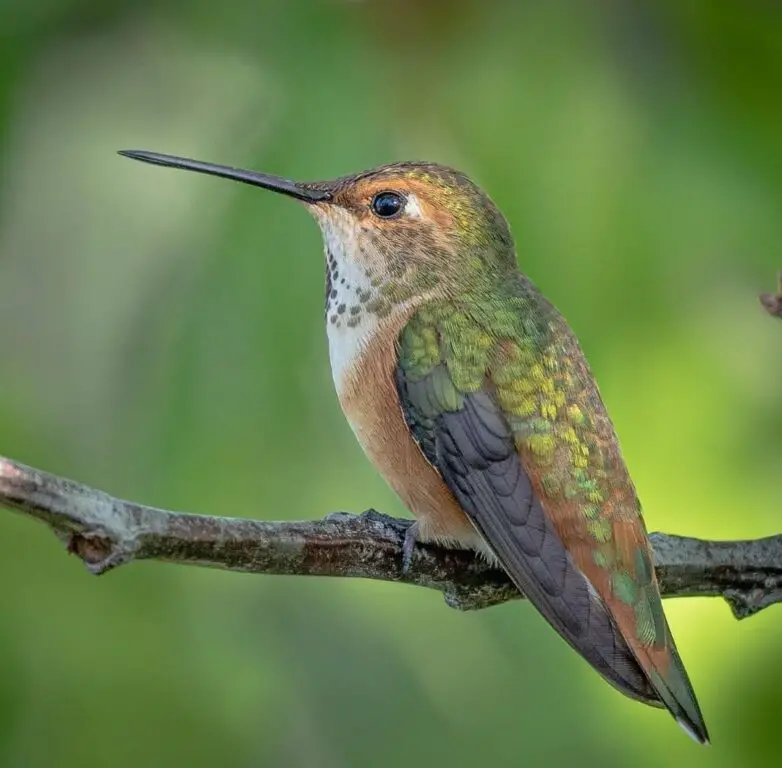
Photo by: Bob Free
They have one of the northernmost breeding ranges of any hummingbird in the world; migrating north from Mexico and nesting as far north as Alaska to breed during the summer months.
They are polygamous and will mate with several partners in a season.
Read my article: Hummingbird Parents: (Mating to Nesting)
Read my article: Baby Hummingbirds: (Egg to Fledgling)
Juvenile Rufous hummingbirds:
In the wild, juvenile Rufous hummingbirds and Allen’s hummingbirds are nearly identical in terms of color and behavior. Therefore, range rather than appearance is used to establish identity.
The juvenile male Rufous’s rustic appearance is attributed to the iridescent orange dots on their neck.
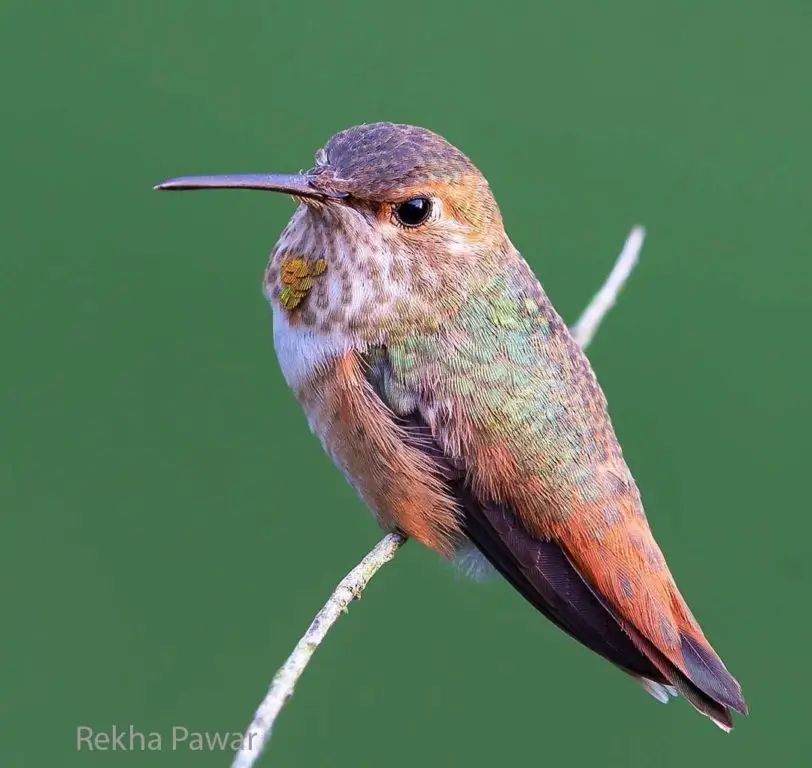
Photo by: Rekha Pawar

Note: The throat feathers are slowly coming in, displaying a few dots of color near his neckline and showing the first stages of adolescence.
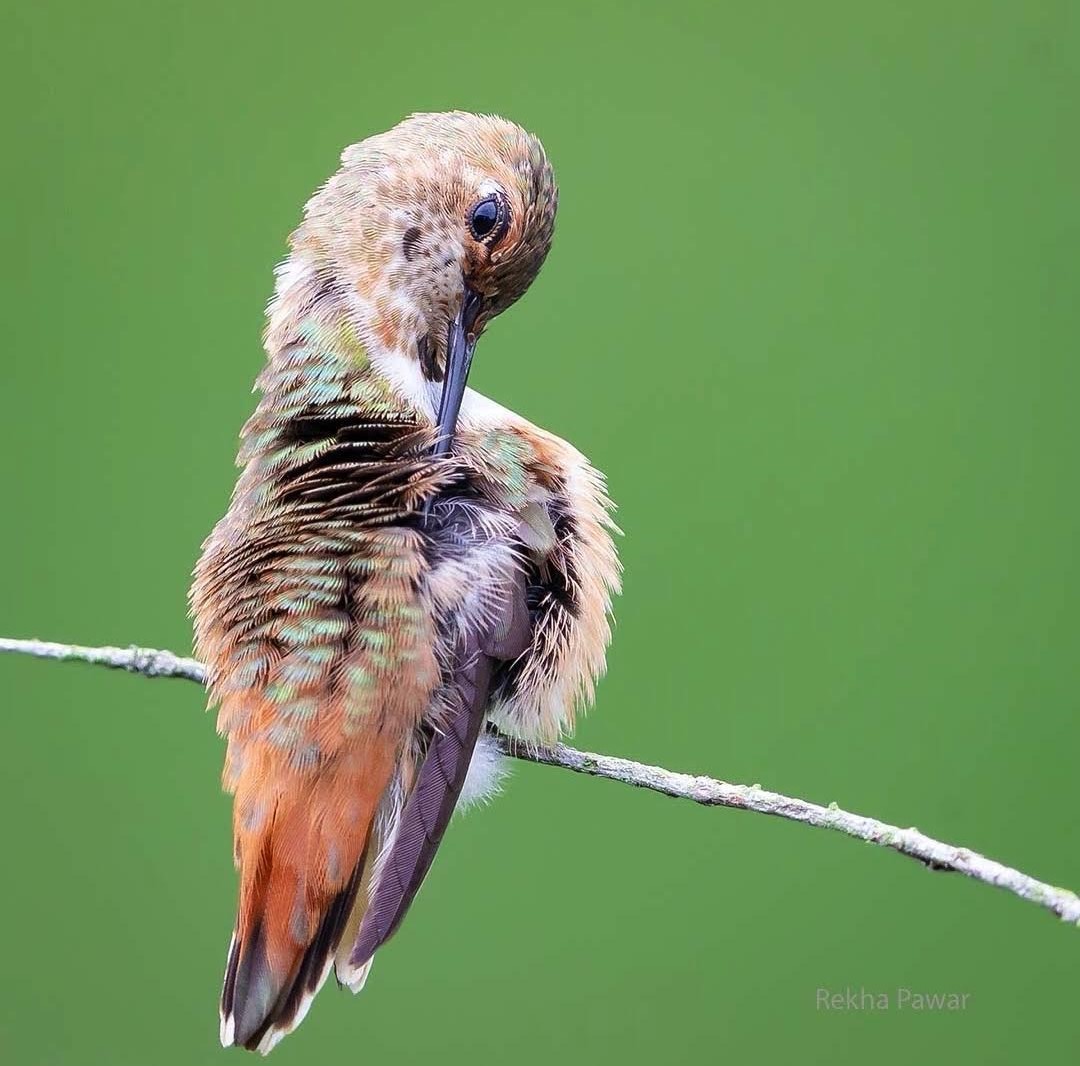
Photo by: Rekha Pawar
Note: Preening flight feathers is an important daily routine to maintain hygiene and to keep the feathers flexible, strong, in alignment, and parasite-free.
Baby Rufous hummingbirds:
Baby Rufous hummingbirds are easily identified by their undertail coverts, which are white fluffy feathers near their bottom that will disappear as they age.
See my article: Baby Hummingbirds: (Egg to Fledgling)
To see the current sighting map of Rufous hummingbirds in Connecticut, click the link.
Hear the sounds of the Rufous hummingbird (Cornell Lab of Ornithology link).
0.71% of all Connecticut hummingbird sightings will be Rufous hummingbirds.
On average, out of 10,000 hummingbird sightings in Connecticut 71 will be the Rufous hummingbird.
Of all the birds in the world, Rufous hummingbirds migrate within the United States for the longest period of time. Every year, they traverse 3,900 miles in a clockwise manner around western America.
This migratory pattern during the seasons coordinates their arrival perfectly while catching nectar and blooming flowers throughout the year, fueling their bodies for their long journey.
In order to support a healthy migration, hummingbird enthusiasts are very beneficial when they cultivate blooming plants to draw hummingbirds and supply feeders with homemade hummingbird nectar. These friendly environments offer and guarantee safe trips in addition to a dependable haven for relaxation and refueling while on the road.
The most likely hummingbird to be seen in a Connecticut winter would be the Rufous hummingbird.
The majority of people are unaware of how tolerant hummingbirds are of chilly weather.
According to eBird, through branding practices in Wisconsin, the Ruby-throated and Rufous hummingbirds have been documented surviving in temperatures of -9F and wind chills of -36F.
Read my article: 3 Reasons Why Hummingbirds Are Banded
Many Connecticut hummingbird admirers leave hummingbird feeders up all winter long to provide life-nourishing nectar to the most commonly seen residents: the Rufous hummingbird.
This selfless act also provides nectar to other migrating species that are too injured or older to travel or unable to migrate.
See my article: 11 DIY Ways to Keep Hummingbird Nectar From Freezing
Some Rufous hummingbirds will also choose to move south to Mexico rather than stay in Connecticut for the winter.
When it comes to other hummingbirds and animals, Rufous hummingbirds are fiercely possessive and hostile. They are known for being aggressive and bold, driving large birds and rodents away from their favorite feeders in addition to other hummingbirds.
See my article: Why Hummingbirds Chase Each Other: Is it Friend or Foe?
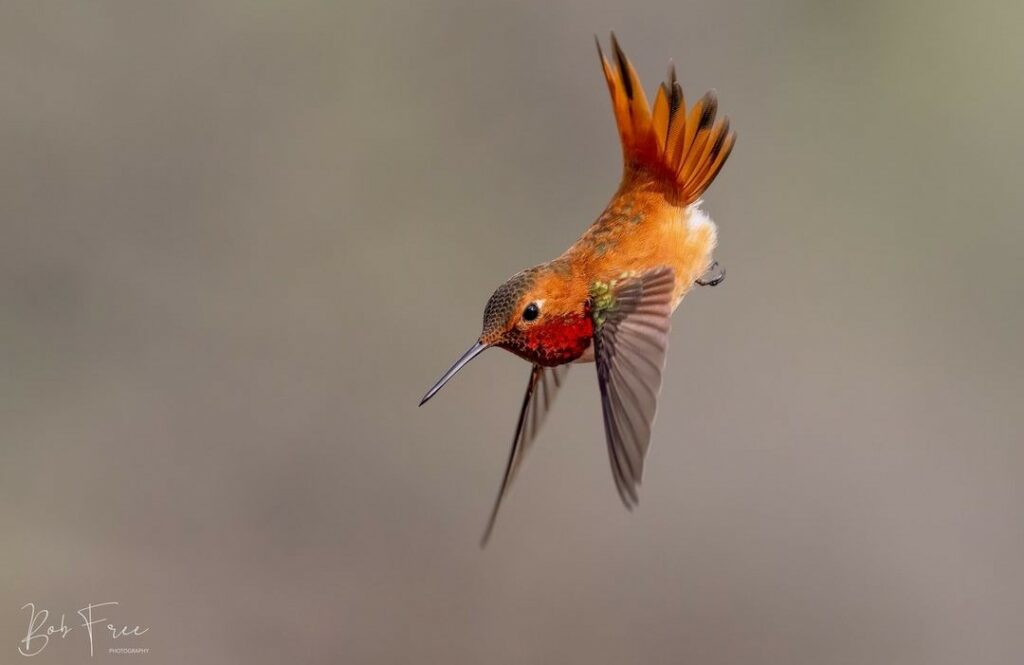
Photo by: Bob Free
It has even been observed that female mothers may attack squirrels and chipmunks that approach their nest too closely.
Due to their remarkable memory, Rufous hummingbirds have been observed to search for an abandoned hummingbird feeder years after it has been taken down.
Read my article: Hummingbird Adaptation and Remarkable Ability to Locate Food
Because of their unparalleled flying acrobatics, Rufous hummingbirds are fierce competitors at feeders, outmaneuvering all other species.
Rufous hummingbirds easily hybridize and cross-breed with other hummingbird species, such as Anna’s hummingbirds.
IUCN Red List classifies the Rufous hummingbird as “near threatened” because of habitat destruction in the Pacific Northwest.
In British Columbia, during a banding operation, the oldest living Rufous hummingbird was documented at 8 years and 10 months old.
Read my article: 3 Reasons Why Hummingbirds Are Banded
Calliope hummingbirds are named after a Greek mythological muse, who represented poetry and eloquence. Calliope means “beautiful voice” in ancient Greek.
Male Calliope hummingbirds:
The long, stunning row of feathers that protrude down the sides of the throat and their iridescent purple cap are characteristics that make male Calliope hummingbirds clearly identifiable.
These hummingbirds, which are 3 inches long and weigh 2-3 grams, have shiny green backs like many others.
The metal plate that shields the wearer’s throat during combat to prevent injuries is the inspiration behind the name of the gorget on a male hummingbird. This name is acceptable and fitting to characterize the physical characteristics of male hummingbirds, since they fight fiercely for their own territory.
Read my article: Hummingbird Gorgets Explained
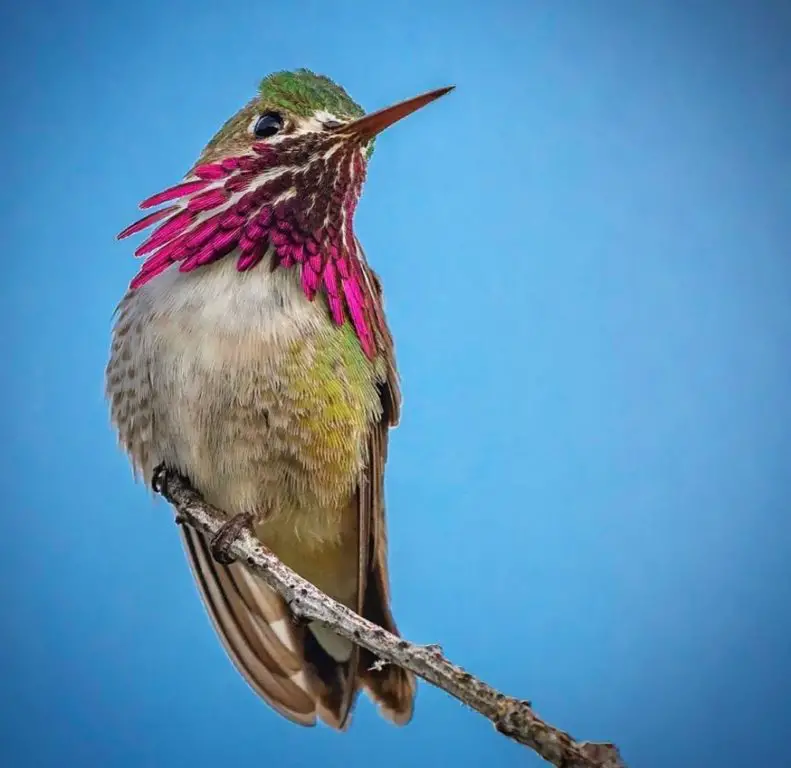
Photo by: sony_alpha_male
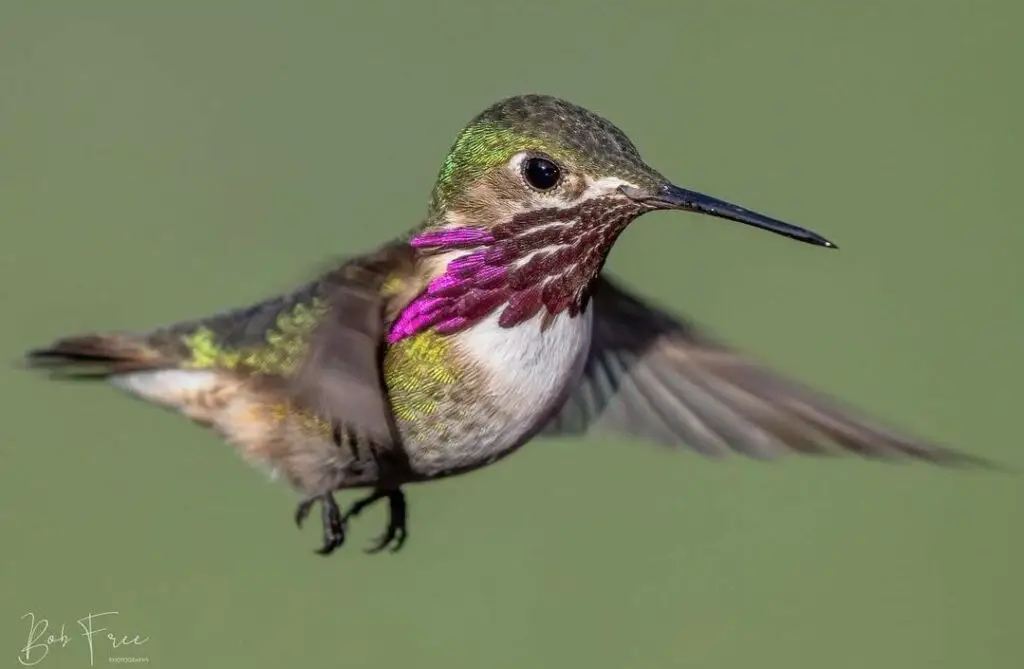
Photo by: Bob Free

Photo by: Bob Free
Female Calliope hummingbirds:
The female Calliope hummingbird is less colorful than the male and lacks a gorget and iridescent feathers. Their head’s crown, or top, has a grayish-green hue. The buff hue of the flanks refers to the sides, underbelly, and area beneath the wings.
See my article: Hummingbird Parents: (Mating to Nesting)

Photo by: sony_alpha_male

Photo by: Anthony Lujan

Photo by: Anthony Lujan
Juvenile Calliope hummingbirds:
Male and female juvenile Calliope hummingbirds initially resemble adult females until the male starts to develop the iridescent feathers that are characteristic of this species of hummingbird.
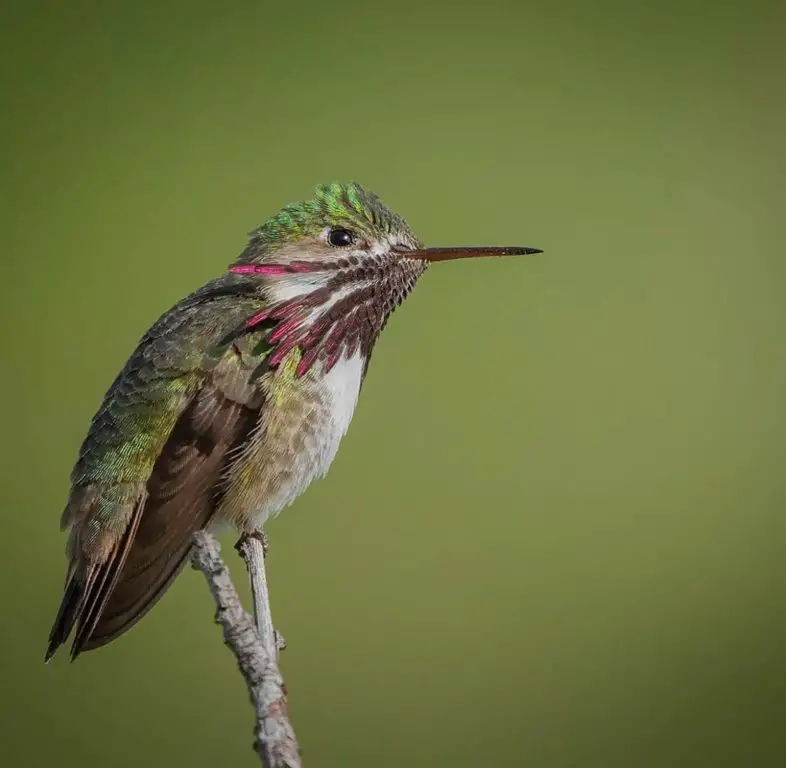
Photo by: sony_alpha_male
Note: His bright throat feathers are slowly coming in.
Baby Calliope hummingbirds:
Baby Calliope hummingbirds are easily identified by their undertail coverts, which are white fluffy feathers near their bottom that will disappear as they age.
See my article: Baby Hummingbirds: (Egg to Fledgling)
To see the current sighting map of the Calliope hummingbird in Connecticut, click the link.
Hear the sounds of the Calliope hummingbird (Cornell Lab of Ornithology link).
0.09% of all Connecticut hummingbird sightings will be Calliope hummingbirds.
On average, out of 10,000 hummingbird sightings in Connecticut, 9 will be the Calliope hummingbird.
Like many other hummingbirds, Calliopes use their feathers to manipulate their flight path in order to produce a variety of buzzing noises that serve as a type of language.
The male will fervently fly back and forth and perform a “U” shaped courtship display to get the attention of the female when she is quietly perched. The male hummingbird will perform a vocal serenade for the female while swaying his body back and forth in front of her.
See my article: Hummingbird Dance: 5 Interpretive Explanations
A breeding area is established by male Calliope hummingbirds, who mate with any female that accepts their wooing.
In terms of social behavior, Calliope hummingbirds are generally solitary, especially outside of the breeding season. They are territorial, with males often defending prime feeding territories from other hummingbirds.
See my article: Why Hummingbirds Chase Each Other: Is it Friend or Foe?
The world’s smallest long-distance migratory bird is the Calliope hummingbird. Their springtime migration patterns resemble those of Rufous hummingbirds.
Throughout their northward spring migration where they breed, they traverse the Pacific Flyways. On their southbound journey in the fall, they pass through the Pacific and Rocky Mountain Flyways towards their wintering destination in Mexico.
During the breeding season, female Calliope hummingbirds select the tips of pine cones as her building site for her nest. Along with stealing materials from other birds’ nests to build her own, she will also disassemble and recycle previous seasons’ nests.
Therefore, larger and more aggressive hummingbirds, such as Allen’s and Rufous hummingbirds, frequently chase and attack female Calliopes. Compared to other species, the Calliope keeps a low profile in order to evade these attacks.
Calliope hummingbirds hybridize and readily crossbreed with other hummingbird species, such as the Costa’s hummingbird.
Calliope hummingbirds are especially susceptible to habitat loss and natural catastrophes like wildfires and climate change because they have a smaller wintering range than other hummingbird species.
The oldest known female Calliope hummingbird was twice captured during a 2007 and 2014 banding operation in Idaho. She was 8 years and 11 months old at the time of her capture.
See my article: 3 Reasons Why Hummingbirds Are Banded
BLACK-CHINNED HUMMINGBIRD – (Archilochus alexandri)
Conservation Status: Least concerned
Kingdom: Animalia
Phylum: Chordata
Class: Aves
Order: Apodiformes
Family: Trochilidae
Genus: Archilochus
Species: A. alexandri
The Black-chinned hummingbird’s scientific name is in commemoration of Dr. Alexandre, a French doctor who was the first to discover the species in Mexico.
Male Black-chinned hummingbirds:
The royal purple gorget resembling a buttoned-up shirt with a small flash of color right near the neckline is the distinguishing feature of male Black-chinned hummingbirds. The male’s purple gorget or throat in some lighting at times looks entirely black.
Their flanks and backs are metallic green, while their undersides are white. They have a black bill and a forked dark tail.
Their length ranges from 3.25 to 3.5 inches, and they weigh between 2.8 and 5.6 grams.
The metal plate that shields the wearer’s throat during combat to prevent injuries is the inspiration behind the name of the gorget on a male hummingbird. This name is acceptable and fitting to characterize the physical characteristics of male hummingbirds, since they fight fiercely for their own territory.
Read my article: Hummingbird Gorgets Explained
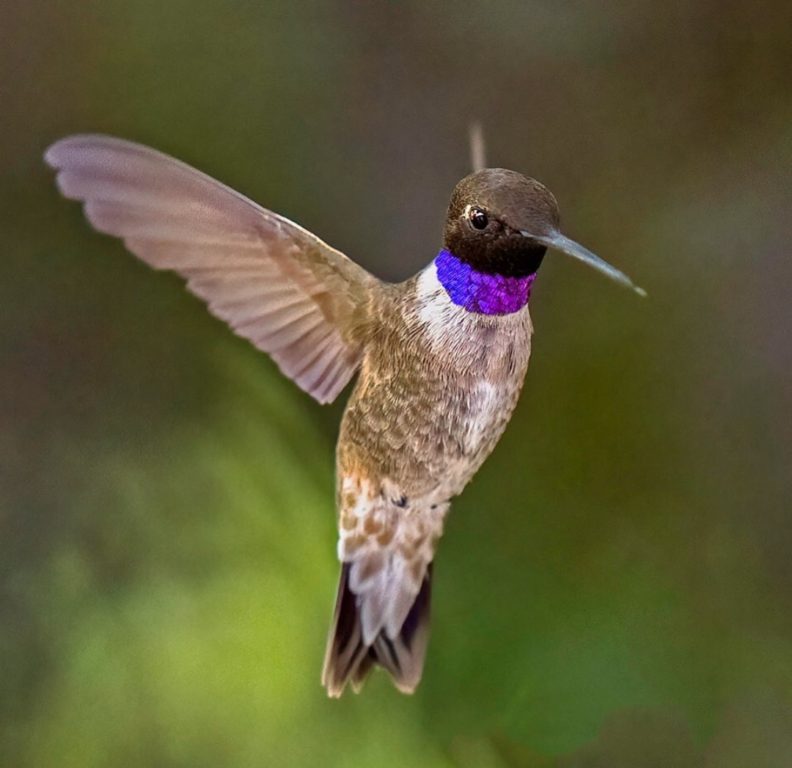
Photo by: sony_alpha_male

Photo by: bird.whisperer
Female Black-chinned hummingbirds:
Compared to their male counterparts, female Black-chinned hummingbirds are less colorful and lack a gorget and iridescent feathers. White tips and beige edges on the dorsal feathers, which turn dark black as they age, adorn their dark, rounded tail, which has a white underbelly. They have dull metallic marbled colors on their head and backs that resemble snake scales: beige, green, white, yellow-green, and dark brown.
Read my article: Hummingbird Parents: (Mating to Nesting)
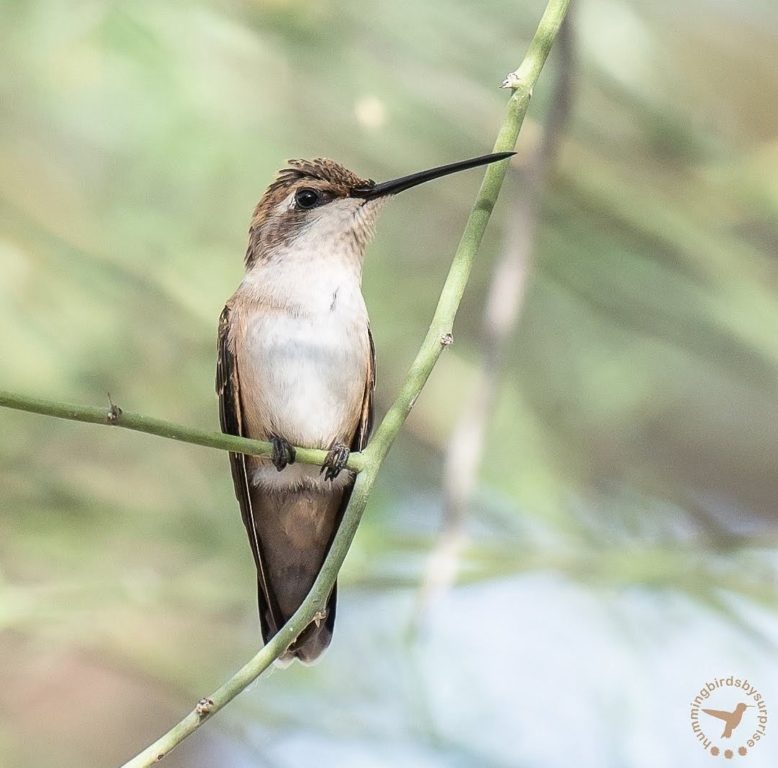
Photo by: hummingbirdsbysurpise
Juvenile Black-chinned hummingbirds:
Male and female juvenile Black-chinned hummingbirds initially resemble adult females until the male starts to develop the iridescent feathers that are characteristic of this species of hummingbird.
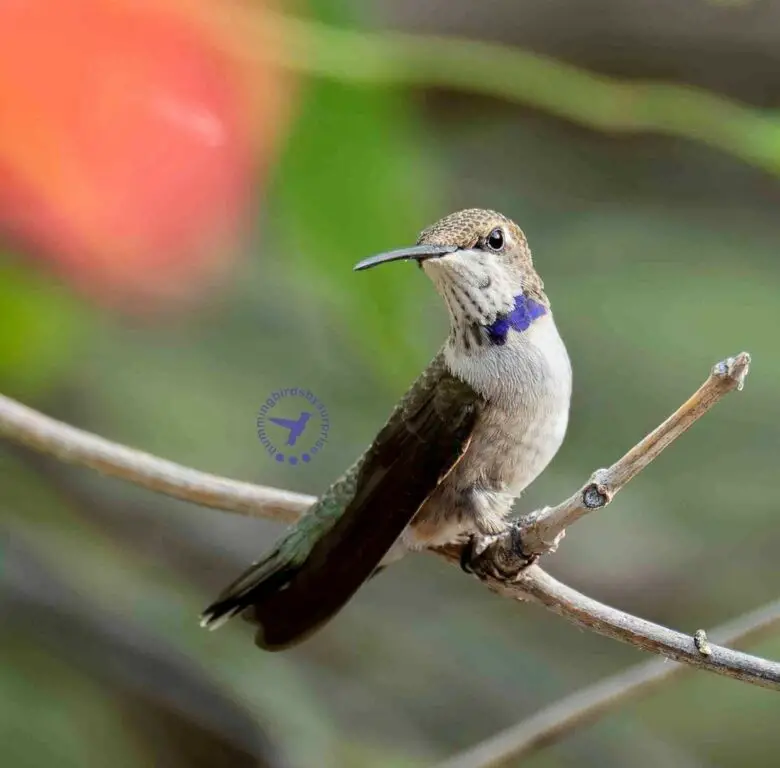
Photo by: hummingbirdsbysuprise
Baby Black-chinned hummingbirds:
Baby Black-chinned hummingbirds are easily identified by their undertail coverts, which are white fluffy feathers near their bottom that will disappear as they age.
See my article: Baby Hummingbirds: (Egg to Fledgling)
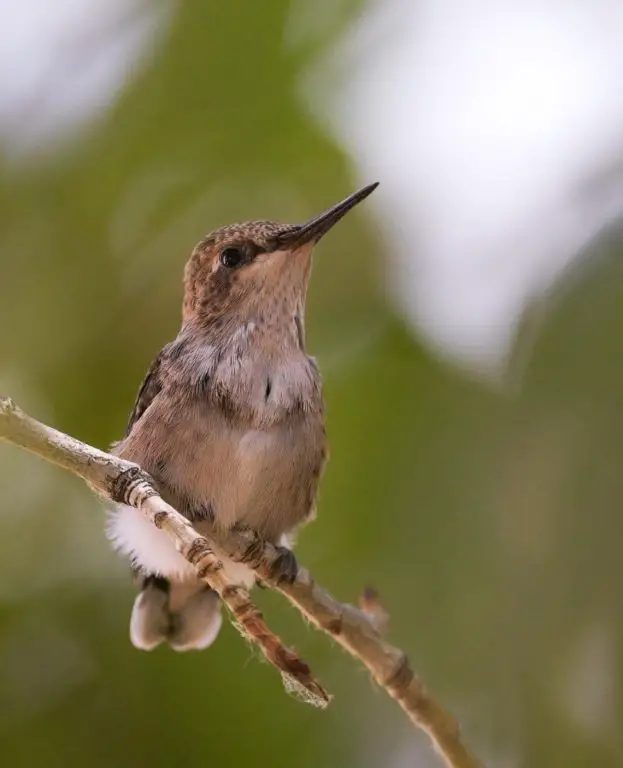
Photo by: bird.whisperer
To see the current sighting map of the Black-chinned hummingbird in Connecticut, click the link.
Hear the sounds of the Black-chinned hummingbird (Cornell Lab of Ornithology link).
0.05% of all Connecticut hummingbird sightings will be Black-chinned hummingbirds.
On average, out of 10,000 hummingbird sightings in Connecticut, 5 will be the Black-chinned hummingbird.
Black-chinned hummingbirds breed to the east of the Cascade mountain range. By employing a decoy tactic, they are known to build their nests close to larger, busier bird nests, hence decreasing the likelihood of predators nearby.
Of all extant mammals or vertebrates, Black-chinned hummingbirds have the least amount of genetic material known to science. Due to their little size, they run the risk of becoming prey for larger birds that consume insects.
See my article: 10 Common Things That Kill Hummingbirds
Particularly while protecting “their” feeders, hummingbirds come across as the most ruthless sheriff in the area due to their intense territoriality. To defend nectar sources full of blooming plants that attract hummingbirds, they will engage in territorial conflicts.
Although Black-chinned hummingbirds are a territorial species, they will become less aggressive and learn to share if they happen to be in an area with a high hummingbird population and food sources.
See my article: Why Hummingbirds Chase Each Other: Is it Friend or Foe?
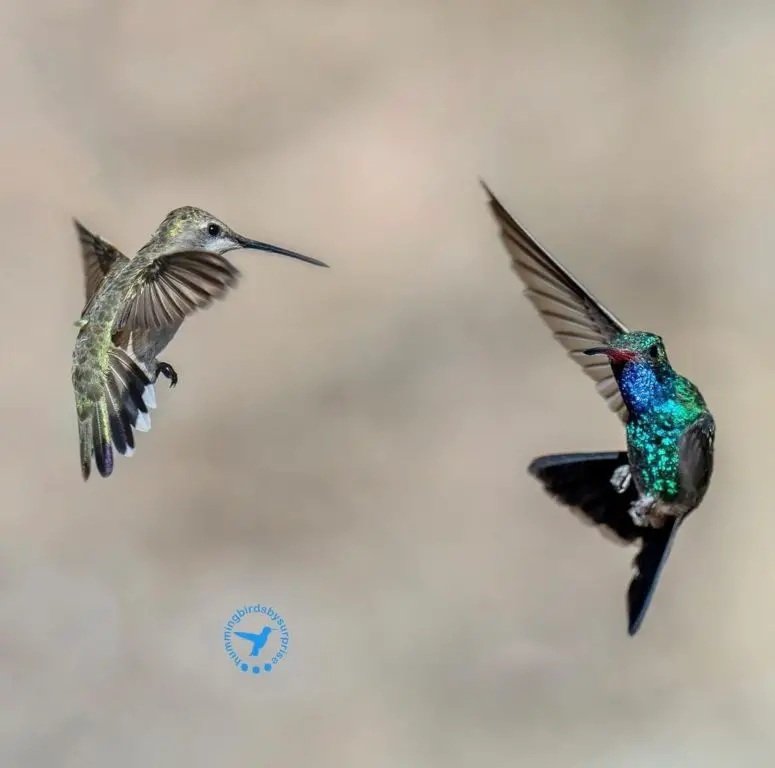
Photo by: hummingbirdsbysuprise
Black-chinned hummingbirds easily hybridize and interbreed with other hummingbird species, including Costa’s and Anna’s. The lifespan of a Black-chinned hummingbird is an astounding ten years, compared to other animals and birds of comparable size.
In Texas, during a banding and capture effort, the oldest known female Black-chinned hummingbird was 11 years and 2 months old.
See my article: 3 Reasons Why Hummingbirds Are Banded
BROAD-BILLED HUMMINGBIRD – (Cynanthus latirostris)
Conservation Status: Least concerned
Kingdom: Animalia
Phylum: Chordata
Class: Aves
Order: Apodiformes
Family: Trochilidae
Genus: Cynanthus
Species: C. latirostris
The Broad-billed hummingbird, scientifically named Cynanthus latirostris, is known for its distinctive broad bill, which is the origin of its common name.
Their broad bills are particularly adapted for feeding on a variety of flowers.
Although most of the population of Broad-billed hummingbirds remains in Mexico and Central America throughout the year, they are a Mexican species that regularly visits the United States close to the southern Mexican border.
Male Broad-billed hummingbirds:
The brilliant blue-green gorget of male Broad-billed hummingbirds stretches back towards their shoulders. Male juveniles display a full charcoal dark gray body with light green neck and backside, and flecks of metallic blue on their throat.
They have a long, brilliant orange-red beak with a distinctive black tip.
Their length varies from 3.25 to 4 inches, and they weigh between 3 and 4 grams.
The metal plate that shields the wearer’s throat during combat to prevent injuries is the inspiration behind the name of the gorget on a male hummingbird. This name is acceptable and fitting to characterize the physical characteristics of male hummingbirds, since they fight fiercely for their own territory.
Read my article: Hummingbird Gorgets Explained

Photo by: Anthony Lujan
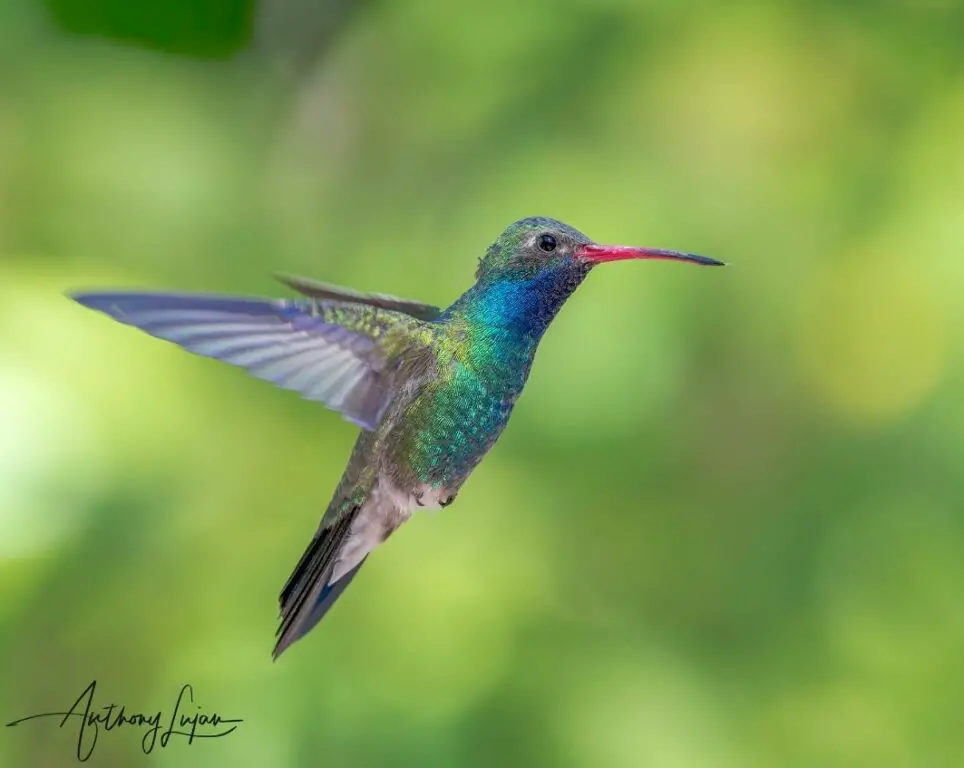
Photo by: Anthony Lujan
Female Broad-billed hummingbirds:
Generally speaking, female Broad-billed hummingbirds lack iridescent feathers and have a duller appearance than males. Their bill is entirely black, with a larger white accent over their eyes. They can be recognized by their mainly metallic green upperparts and white undersides. Their tails are forked and have a black tint.
Juvenile Broad-billed hummingbirds:
Male and female juvenile Broad-billed hummingbirds initially resemble adult females until the male starts to develop the iridescent feathers that are characteristic of this species of hummingbird.
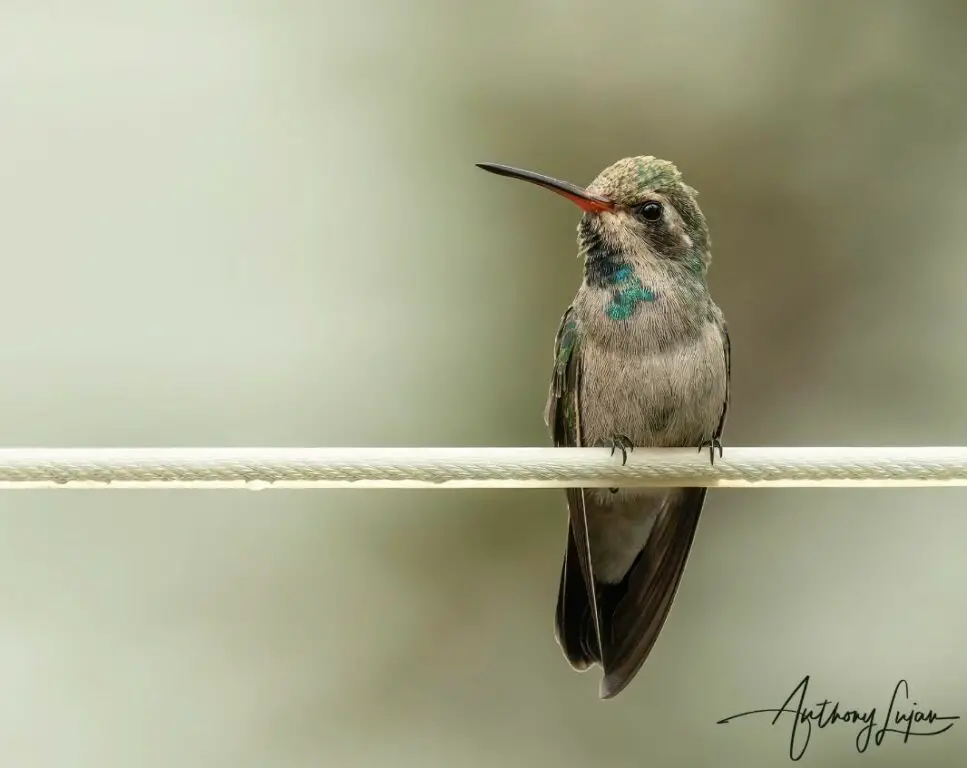
Photo by: Anthony Lujan
Baby Broad-billed hummingbirds:
Baby Broad-billed hummingbirds are easily identified by their undertail coverts, which are white fluffy feathers near their bottom that will disappear as they age.
See my article: Baby Hummingbirds: (Egg to Fledgling)

Photo by: hummingbirdsbysuprise
To see the current sighting map of Connecticut’s Broad-billed hummingbirds, click the link.
Hear the sounds of the Broad-billed hummingbird (Cornell Lab of Ornithology link).
On average, out of 40,000 hummingbird sightings in Connecticut, only 1 will be of the Broad-billed hummingbird.
Broad-billed hummingbirds are native to the southwestern United States, Mexico, and down into Central America. They prefer habitats such as canyons, riverine woodlands, and sometimes gardens or urban areas with suitable flowering plants.
Nests made by Broad-billed hummingbirds are identified by their lack of lichen decoration on the exterior. Instead, the birds prefer to build their nests utilizing outside grass fibers, leaf fragments, and bark, and then utilize spider webs to secure and maintain the structure of the nest. The female constructs a nest that is suspended from a single, long, thin branch.
See my article: Hummingbird Parents: (Mating to Nesting)
Particularly while defending “their” feeders, Broad-billed hummingbirds come across as the meanest sheriff in the community due to their intense territoriality. They will engage in territorial conflicts to defend nectar sources that are home to blooming plants that attract hummingbirds.
See my article: Why Hummingbirds Chase Each Other: Is it Friend or Foe?

Photo by: Anthony Lujan
Surprisingly, the Broad-billed hummingbird has demonstrated a real overall population growth in recent years, in contrast to other hummingbird population surveys.
The future of the Broad-billed hummingbird, like many wildlife species, depends on the preservation of their habitats and understanding the impacts of environmental changes. Conservation efforts and responsible practices in gardening and feeder maintenance can aid in their survival.
When the oldest male Broad-billed hummingbird was caught and released in Arizona during a banding operation, he was 9 years and 1 month old.
See my article: 3 Reasons Why Hummingbirds Are Banded
Mexican Violetear Hummingbirds:
MEXICAN VIOLETEAR (aka GREEN VIOLETEAR) HUMMINGBIRD – (Colibri thalassinus)
Conservation Status: Least concerned
Kingdom: Animalia
Phylum: Chordata
Class: Aves
Order: Apodiformes
Family: Trochilidae
Genus: Colibri
Species: C. thalassinus
Scientifically speaking, the Mexican Violetear is a species of hummingbird, Colibri thalassinus.
Thalassinus is a Latin term meaning “color of the sea.” The characteristic violet patch of feathers on the sides of this hummingbird’s head, which mimics an ear, gave rise to its popular name. The “violetear” description is accurate and vivid because of this bright patch that stands out against the bird’s otherwise green plumage.
Male Mexican Violetear hummingbirds:
The term “violet-ears” refers to the iridescent green color of male Mexican Violetear hummingbirds, which have brilliant violet ear patches on either side of their neck.
This hummingbird has metallic blue-green tail feathers with a black band underneath the bronze tail feathers in the center.
They weigh between 5 and 6 grams and have lengths ranging from 3.8 to 4.7 inches.
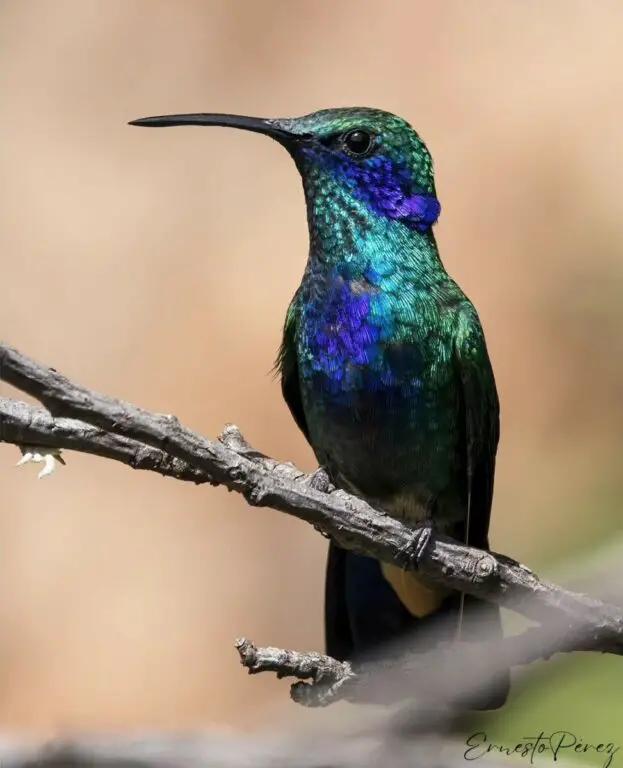
Photo by: Ernesto Perez
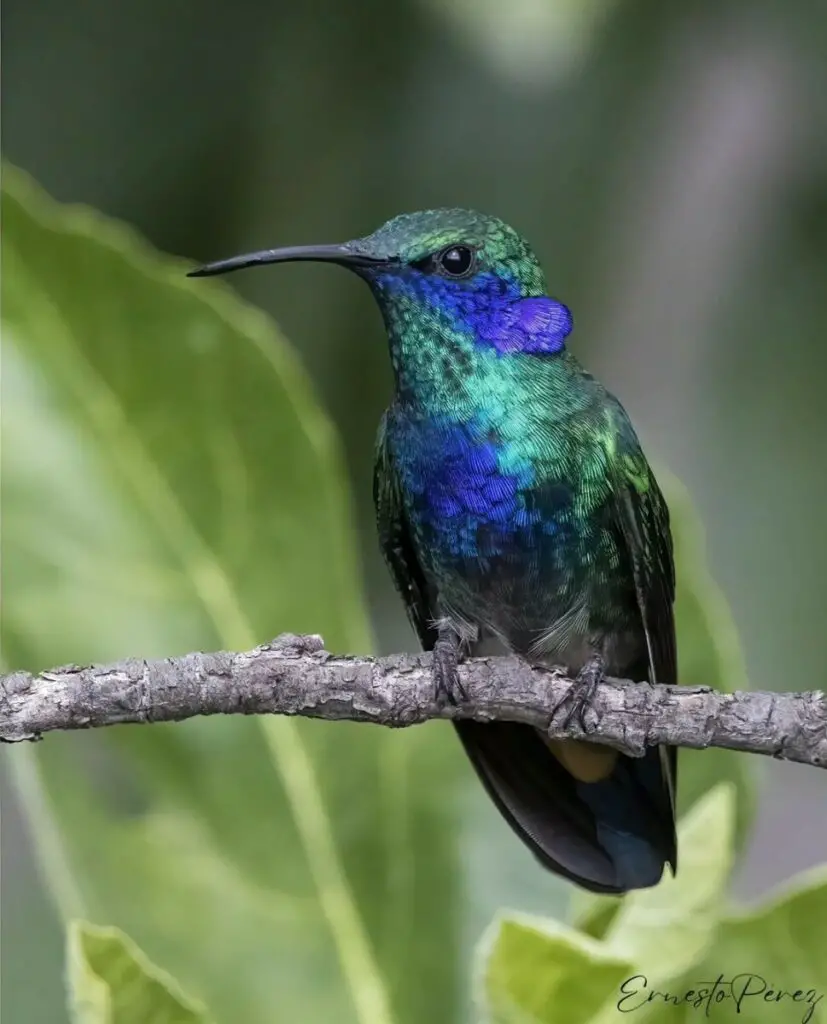
Photo by: Ernesto Perez
Female Mexican Violetear hummingbirds:
Females typically have a less vibrant coloration compared to males. They have a primarily green plumage, which can appear as a dull green or blue-green. The green is iridescent and may shine with different intensities and hues in various lighting conditions.
The violet ear patches are present in females but are often less pronounced than in males.
The underparts of the female are typically a duller green compared to the males, and they may have some grayish or whitish markings.
The tail is typically dark, forked, and can have some blue or green iridescence. It is usually less spectacular than that of the male.
See my article: Hummingbird Parents: (Mating to Nesting)
Juvenile Mexican Violetear hummingbirds:
Male and female Mexican Violetear hummingbirds in their juvenile years resemble adult females until the male starts to develop the characteristic iridescent violet ear patches on either side of his neck.
Baby Mexican Violetear hummingbirds: Baby Mexican Violetear hummingbirds are easily identified by their undertail coverts, which are white fluffy feathers near their bottom that will disappear as they age.
See my article: Baby Hummingbirds: (Egg to Fledgling)
To see the current sighting map of Connecticut’s Mexican Violetear hummingbirds, click the link.
Hear the sounds of the Mexican Violetear hummingbird (Cornell Lab of Ornithology link).
On average, out of 40,000 hummingbird sightings in Connecticut, only 1 will be of the Mexican Violetear hummingbird.
From Mexico to Nicaragua, these hummingbird species are found on the outskirts of cloud forests, where they thrive in an environment with high levels of tropical humidity. It is common to see this dark hummingbird at forest margins and clearings.
Mexican Violetear hummingbirds are semi-nomadic. Since they have not been thoroughly examined, scientists know very little about their migration patterns. However, based on available data, the Mexican Violetear is primarily distributed in northern South America, middle Mexico, and middle America.
Although Mexican Violetear hummingbirds are typically permanent residents of their natural habitat, a few individuals have strayed and ventured as far north as Wisconsin, Michigan, and even Canada.
Much like a lot of other hummingbird species, the Mexican Violetear hummingbird nests alone. Although they do not feed in flocks, these hummingbirds are observed in groups around flowering trees, such as the coffee-shading Inga tree, where they scavenge for nectar and insects.
In terms of social behavior, Mexican Violetear hummingbirds are generally solitary, especially outside of the breeding season. They can be territorial, with males often defending prime feeding territories from other hummingbirds.
See my article: Why Hummingbirds Chase Each Other: Is it Friend or Foe?
The oldest known Mexican Violetear hummingbird was documented to be at least 11 years and 2 months old. This information is based on banding records, where birds are captured, banded with a unique identification ring, and then potentially recaptured or found in the future. The age of this particular Mexican Violetear was determined by the length of time between its initial banding and its last documented recapture or sighting.
See my article: 3 Reasons Why Hummingbirds Are Banded
There are no White-eared hummingbirds documented by the eBird.org sighting map as seen in Connecticut, however, a top Google-ranked site adds this bird to the list.
WHITE-EARED HUMMINGBIRD – (Hylocharis leucotis)
Conservation Status: Least concerned
Kingdom: Animalia
Phylum: Chordata
Class: Aves
Order: Apodiformes
Family: Trochilidae
Genus: Hylocharis
Species: H. leucotis
Hylocharis leucotis, the scientific name for the White-eared hummingbird, is formed from the Latin words hylo, which means “wood or matter,” and charis, which is derived from a Greek term meaning goddesses of beauty and elegance; leuco, which means “white or without color,” and otis, which means “ear.”
Male White-eared hummingbirds:
The green on the back of male White-eared hummingbirds ranges from Granny Smith apple green to dark emerald, with patches of iridescent blue in their gorgets and upper chest.
The throat and crown iridescent feathers may seem black in lower light.
They have an eye-to-neck white stripe that is both distinct and conspicuous.
A White-eared hummingbird’s bill is half black and half red, shorter than the typical hummingbird bill.
They have a length of 3.5–3.9 inches and a weight of 3–4 grams.
The metal plate that shields the wearer’s throat during combat to prevent injuries is the inspiration behind the name of the gorget on a male hummingbird. This name is acceptable and fitting to characterize the physical characteristics of male hummingbirds, since they fight fiercely for their own territory.
Read my article: Hummingbird Gorgets Explained

Photo by: Ernesto Perez
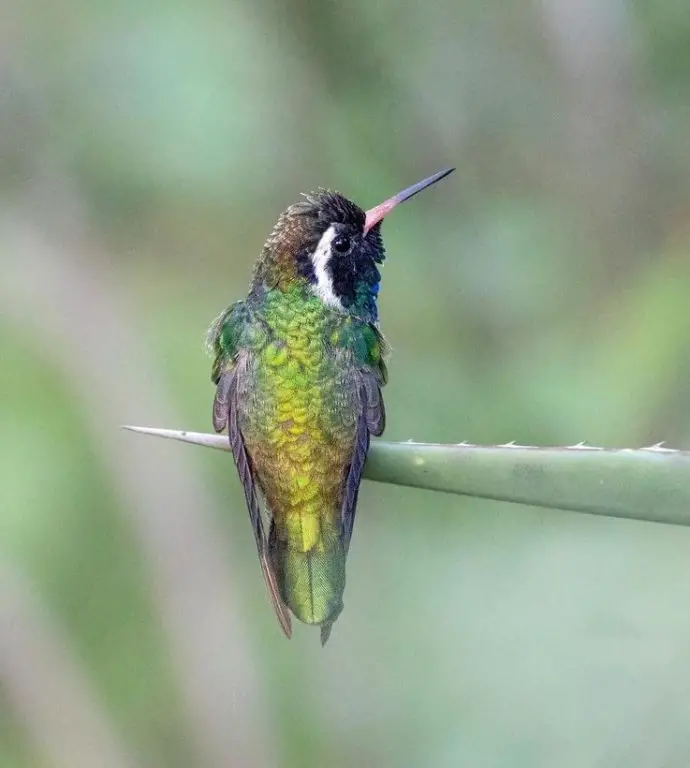
Photo by: jordanmartin_photography
Female White-eared hummingbirds:
The female White-eared hummingbird has a distinct appearance that sets her apart from the male of the species. She is smaller in size and less vividly colored compared to the male.
Her upper parts are mostly a bronzy dull green, which helps with camouflage in her natural habitats.
The white stripe behind the eye for which the species is named is a more subtle and diffused grayish-white patch.
Her underparts are generally grayish, blending into a more whitish color on the throat and center of the belly. This whitish area is less pronounced than in the male. The tail is typically greenish-bronze, with white tips on the outer feathers, a feature that is also less conspicuous than in her male counterpart.
She is among the medium-sized hummingbirds weighing 3 to 4 grams with a length of 9 to 10 centimeters from the tip of her beak to the end of her tail.
See my article: Hummingbird Parents: (Mating to Nesting)
Juvenile White-eared hummingbirds:
Both male and female White-eared hummingbirds look more like adult females until they are differentiated as the male begins to acquire an iridescent turquoise on their throats and possesses a distinct and noticeable thick white stripe that spans from the eye to the neck that is typical of this species of hummingbird. The noticeable white stripe begins to develop early.
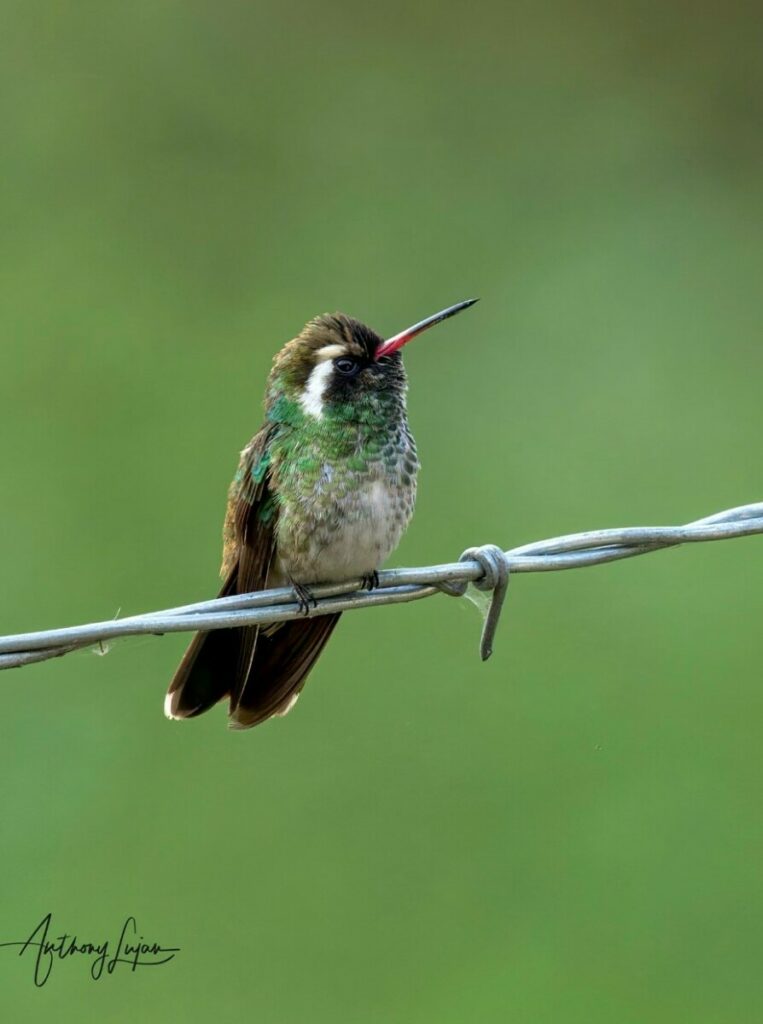
Photo by: Anthony Lujan
Baby White-eared hummingbirds:
Baby White-eared hummingbirds are easily identified by their undertail coverts, which are white fluffy feathers near their bottom that will disappear as they age.
See my article: Baby Hummingbirds: (Egg to Fledgling)
To see the current sighting map of Connecticut’s White-eared hummingbirds, click the link.
Hear the sounds of the White-eared hummingbird (Cornell Lab of Ornithology link).
White-eared hummingbirds are found in a variety of habitats, ranging from mountainous regions to forested areas.
Their habitat consists of pine-oak forests with tropical dry and moist coniferous forests. These climates provide constant rainfall with humidity, warm summers and colder winters.
White-eared hummingbirds are known for their territorial nature, especially around feeding areas. Males are particularly aggressive in defending territories against other males and sometimes even larger bird species. Their flight skills are remarkable, capable of rapid directional changes and hovering with precision.
See my article: Why Hummingbirds Chase Each Other: Is it Friend or Foe?
While some populations of White-eared hummingbirds are resident in their habitats year-round, others undertake migrations. Birds in the northern part of their range often migrate southward during the colder months, returning north again for the breeding season.
Read my article: Connecticut Hummingbird Migration
Hummingbird feeders filled with homemade sugar water attract White-eared hummingbirds, who are frequently welcomed visitors in gardens. They are interesting to birdwatchers and wildlife lovers, and they are good for the ecosystem because they are essential to pollination.
Which Connecticut Hummingbirds Are Most Frequently Seen In The State?
The most frequently seen Connecticut hummingbird is the Ruby-throated hummingbird.
Connecticut hummingbirds listed in the order of frequency seen:
Ruby-throated hummingbird: 99% of all hummingbirds seen in Connecticut are the Ruby-throated hummingbird. Out of 10,000 Connecticut hummingbirds seen, 9,913 will be the Ruby-throated hummingbird.
Rufous hummingbird: 0.71% of all hummingbirds seen in Connecticut are the Rufous hummingbird. Out of 10,000 Connecticut hummingbirds seen, only 71 will be the Rufous hummingbird.
Calliope hummingbird: 0.09% of all hummingbirds seen in Connecticut are the Calliope hummingbird. Out of 10,000 Connecticut hummingbirds seen, only 9 will be the Calliope hummingbird.
Black-chinned hummingbird: 0.05% of all hummingbirds seen in Connecticut are the Black-chinned hummingbird. Out of 10,000 Connecticut hummingbirds seen, only 5 will be the Black-chinned hummingbird.
Broad-billed hummingbird: Out of 40,000 Connecticut hummingbirds seen, only 1 will be the Broad-billed hummingbird.
Mexican Violetear: Out of 40,000 Connecticut hummingbirds seen, only 1 will be the Mexican Violetear hummingbird.
White-eared hummingbird: There are no sightings of the white-eared hummingbird on eBird sighting map, however, a top-ranked Google site lists the White-eared hummingbird as a Connecticut hummingbird.
Where In The State Are Connecticut Hummingbirds Seen?
Hummingbirds are seen in Connecticut throughout the state.
Some are seen throughout the entirety of the state, while others are only seen in specific, limited areas of Connecticut.
Click the link below to see the current sighting map of where
Connecticut hummingbirds are being seen (eBird.org links)
Ruby-throated hummingbird: This is where, in Connecticut, current sightings of this hummingbird are being reported.
Rufous hummingbird: This is where, in Connecticut, current sightings of this hummingbird are being reported.
Calliope hummingbird: This is where, in Connecticut, current sightings of this hummingbird are being reported.
Black-chinned hummingbird: This is where, in Connecticut, current sightings of this hummingbird are being reported.
Broad-billed hummingbird: This is where, in Connecticut, current sightings of this hummingbird are being reported.
Mexican Violetear: This is where, in Connecticut, current sightings of this hummingbird are being reported.
White-eared hummingbird: This is where, in Connecticut, current sightings of this hummingbird are being reported.
Read my article: Connecticut Hummingbird Migration
Check out my other posts on Hummingbird Questions
Happy Hummingbird Watching!
Backyard Visitors participates in affiliate programs which compensate us for referring traffic.

